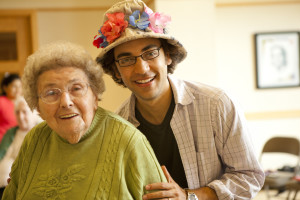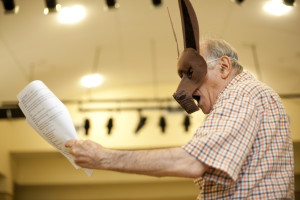Tags
Related Posts
Share This
Still Dreaming

Co-Directors Hank Rogerson and Jilann Spitzmiller take a break from shooting rehearsals. Photo by Genevieve Russell
“It’s a very simple premise: Let’s get together and do a play no matter how good it is,” says filmmaker Jilann Spitzmiller who, along with her husband, Film School instructor Hank Rogerson, illustrates the situation of their latest documentary Still Dreaming. The original project, Spitzmiller and Rogerson explain, came after the success of their 2005 documentary Shakespeare Behind Bars, which challenged a group of inmates to perform The Tempest. The artistic couple was then prompted to a new challenge: taking Shakespeare to the elderly.
“I started thinking what it would it be like to be creative at 80,” Rogerson says, reflecting on the Still Dreaming project, which he and Spitzmiller shot four years ago. “Jilann and I are partners in creativity, we make films together and we love storytelling. Can we still do that when we’re 80? This film was sort of an attempt to answer that question.”
Still Dreaming comes to The Screen Friday, March 27 and includes a Q&A session, and also screens March 28-29.
In addition to the couple’s exploration of creativity and aging, Spitzmiller shares that her connection with the project extends also to her grandmother, who she recalls had a terrible end of life and felt it was unjustly so. “Aging can be a happy, fertile and amazing time,” Spitzmiller says. “If we can change the perspective of what it is and what it can be, everyone can benefit.” Spitzmiller points out that in Still Dreaming, “here is a group of people who can show us what it is to experience joy, humor and community.”
According to Rogerson and Spitzmiller, their research in the film’s pre-production led them to Lillian Booth Actors Home outside of New York, where residents live out their retirement with some theatrical perks, including a Shakespeare club and an annual Fourth of July reading of the Declaration of Independence.
“In researching the idea it became evident to me that it would be good if they had acting background,” Rogerson says. “We approached the home and they really liked the idea. Then we thought, what if we upped it a little bit? What if we brought in outside directors? What if they actually put on a production?”
After sending a call for directors to New York and Los Angeles, the filmmakers found Noah Brody and Ben Steinfeld, two Broadway directors living in New York.
“It became really evident to us that their approach to theater was right because it was a minimalist approach,” Rogerson says, “which is good for A Midsummer Night’s Dream.” He adds that having the two directors in conversation energized the documentary and because they were young, Rogerson explains, “they fit that generational aspect” which he and Spitzmiller wanted in order to create drama and humor.
“I don’t think they really looked at [the project] from an aging perspective at all,” Spitzmiller says, reflecting on Brody’s and Steinfeld’s participation in the film. “They looked at it through a director’s perspective.” Forgetting the ailments that affected their actors, Spitzmiller says the directors asked their group, “what can we do today?” and dove into production.
“In a way that was a huge release from the way the staff interfaces with [the seniors], which is in a medical way,” Spitzmiller says. “The directors are coming in saying ‘we’re going to interface with you in an artistic way so whatever you came in with today, whatever you can do today, let’s use it.’” And once rehearsals began, Spitzmiller explains, the perception that the actors had of themselves was often disappointment on their loss of talent. But the more they let go, Spitzmiller observed, the more fun they had.
Though the original intent of the project, according to Rogerson and Spitzmiller, was to have residents of Lillian Booth Actors Home perform Romeo and Juliet, the performers preferred the comedy of A Midsummer Night’s Dream, which transformed the theme into one of reality versus dreaming.
“I think it worked out well,” Spitzmiller says. “If everyone is having a different perception of something, what is the truth? Everyone in that room has a different reality if they have a different circumstance in their abilities at that moment.” She explains that with dementia, double vision, fatigue, etc. the performers’ realities often shifted so much that the film “gives you a different idea of this play than what you normally see.”
Regarding the theatrical release, Rogerson says that he’s really excited to have Still Dreaming shown on the big screen, and adds that he’s also excited “to be on the other side” and have his students watch his work.

Mary Depaulo (Quince) and A Midsummer Night’s Dream co-director Noah Brody smile for the camera. Photo by Genevieve Russell
“It’s a great learning opportunity,” Spitzmiller says to the Film School students. “Even though you think you know Hank the professor, to see Hank the filmmaker you may see a side of him you didn’t know.”
And while the hope is that the audience sees a great story with great characters, Spitzmiller adds that “underneath that too is our understanding of our elders, how we can support them better in their lives and also how we can re-envision this idea of aging, not as a death sentence that we don’t talk about, but as something that we look forward to and actively engage in.”
Overall, for all those who watch Still Dreaming, the artistic couple says that their message to them is to never stop dreaming.







 Jackalope Magazine is the student magazine of Santa Fe University of Art and Design. Building on the interdisciplinary nature of our education, we aim to showcase the talent of our university and character of our city.
Jackalope Magazine is the student magazine of Santa Fe University of Art and Design. Building on the interdisciplinary nature of our education, we aim to showcase the talent of our university and character of our city.
Recent Comments